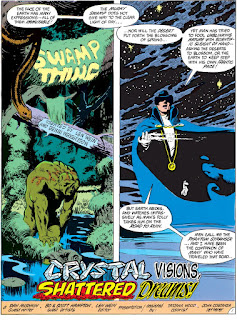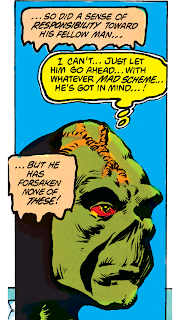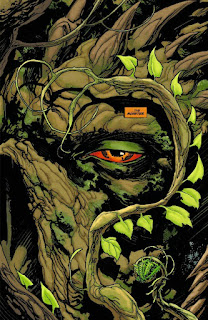Glass Menagerie
Welcome back Parliamentarians! Those of you that read my last post, "Dark Denouement" (and if you haven't yet, go check it out) will remember that we're starting a new format with this installment of Avatar of the Green. Beginning with this post, each installment in the immediate future will feature not only at least one (usually two probably) issues of a Swamp Thing series, but will also include coverage of a "back up" issue of another title featuring characters that are a part of the dark corners of the DC universe. In this installment, our back up issue will be Sandman Mystery Theatre #1, by Matt Wagner and Guy Davis. I hope all of you enjoy this new format, and if proves popular I might even expand it to where every few weeks I have a "Dark Corners" installment that just focuses on the various ancillary titles I've selected.
For now, though, let's focus on the star of this little piece of the blogosphere with Saga of the Swamp Thing issues 14 and 15. Unlike the previous thirteen issues, these two were written by Dan Mishkin. Fans of early 80s DC may recognize Mishkin as the co-creator of both Blue Devil and Amethyst, Princess of Gemworld. The difference in the two author's writing style is almost instantly apparent. While Pasko's storytelling is kind of a cross between late 70s/early 80s horror movie and the X-Files, Mishkin's Swamp Thing story feels almost like a traditional superhero tale of the day, complete with a lab accident, a power mad scientist, and megalomaniacal expository monologues.
What's more, Mishkin's two part arc firmly establishes Saga of the Swamp Thing as being within the greater DC universe.
While the original 70s Swamp Thing series featured an appearance by Batman and Gotham City, and Swamp Thing made appearances in Brave and the Bold in both 1975 and 1981, the first thirteen issues of SotST were absent of references to other DC lore. The only large city seen is Washington DC; no Metropolis, no Gotham, Star, Central, Keystone, or Coast Cities. No men and women in brightly colored spandex are seen or even referenced, giving me the impression that Pasko's stories were intended, at least by him, to be self contained, possibly even in one of pre-Crisis DC's infinite Earths.
In contrast, the opening page of Saga of the Swamp Thing #14 features a monologue by the Phantom Stranger. Readers of Pasko's first thirteen issues of SotST will recognize the fedora wearing mystery man from that run if nothing else, as the Stranger had a back up story in each of those issues, though he has been around in DC publication since 1952, and in pre-Crisis continuity was considered an honorary, if not fully active, member of the Justice League of America. Though Alan Moore would firmly establish Swamp Thing as being a part of pre-Crisis Earth-1 in his classic "Anatomy Lesson" story in SotST #21 with the inclusion of Silver Age villain the Floronic Man, and the cameo appearance of the Justice League itself in issue 24, the appearance of the Stranger actually in a Swamp Thing story would be the first indicator that this series took place within established DC continuity.
Issue 14 introduces us to Nathaniel Broder, a self made millionaire, thanks to his role in "advancing silicon chip technology". While working on an experimental "amorphous silicon" of his own design, Broder suffers a lab accident which bathes him in an avalanche of his own creation, seemingly killing him. The Phantom Stranger appears and stops Broder's wife Sally from opening the lab, which would have led to a large scale environmental disaster.
Sally takes control of Nat's company in the aftermath, though, unknown to her, Broder's business partners have illegally disposed of the waste from the accident in a nearby swamp, which coincidentally happens to be the same swamp where Alec Holland was "transformed" into the Swamp Thing. Broder soon bursts his way out of one of the waste containers, his body now transformed into living crystal. Mindless at first, Broder begins transforming the plants, animals, even the much of the swamp water into crystalized silicon. When Swamp Thing happens across the transformed Broder, the crystal man attacks. He's unable to turn Swamp Thing to crystal (apparently the bio-restorative formula is resistant to the process), but he proves to be Holland's physical superior. Injured, Holland retreats deeper into the swamp.
When he reemerges a short time later he comes across Broder's wife, business partners, and requisite hired goons. Through a confrontation with one of the goons Swamp Thing learns of Broder's fate in the lab and reasons that he and the crystal creature must be one and the same.
Soon after he is approached by the Stranger, who advises Holland that he only understands part of the truth about the crystal creature, but that he must discover the truth for himself. Holland begins to sympathize with Broder and the parallels of their circumstances. When he sees Broder in the distance he calls out to him by name, which snaps the crystal man out of his fugue. Holland quickly realizes, though, that Broder does not see his own transformation as a curse, but as an opportunity to use his newfound abilities to gain even more power. Broder exposits that he had laced micro circuitry into his crystaline formula, making him a living computer, an ability with which, in addition to his superhuman physical abilities and fortune, he plans to use to take over the world. The two clash again, and this time Swamp Thing is not only physically overpowered, but with Broder now in full control of his abilities, is transformed into a living crystaline statue.
Issue 15 opens with the Swamp Thing's transformed body now a trophy at Broder's lab. Though he is secretly planning on using the micro circuitry in his body to hack into and take over the strategic computers of the US and the USSR (early 80s, remember), he's convinced his wife Sally that he is actually searching for a cure for his condition. The bio-restorative formula in Swamp Thing's system eventually reverses his silicon crystal transformation, and he begins making his way as stealthily as he can through Broder's compound, looking for a way to stop the power mad monster.
I should point out the the narration absolutely makes the scene of Holland's infiltration of Broder's complex. If one were to go purely by the art in this sequence it would be easy to assume that Swamp Thing, already defeated twice by a more powerful foe, was trying to escape from Broder's sprawling and mostly underground facility. The narration boxes, however, give us greater insight into Holland's thoughts and movivations. "But fear is an emotion that Alec Holland has all but given up, for it seemed somehow out of place in one of his mossy and mishapen form. But then so did love, and so did courage, so did a sense of responsibility toward his fellow man, but he has forsaken none of these!"
Holland comes to the aid of Broder's assistant Peter, who opposes the crystal man's plan. Peter escapes and warns Sally of the danger, though Broder soon overcomes Swamp Thing again, catches up to Peter, and fatally transforms him to crystal. Holland helps Sally escape, at which point they are both confronted again by the Phantom Stranger, who helps Sally realize the key to stopping Broder; a....synthesizer.
You see, this being the early 80s, the age of new wave synth-pop, Sally of course plays a synthesizer when she's stressed out. Broder, being made entirely of crystal, is particularly sensitive to vibrations. Back inside the compound, while Swamp Thing battles Broder once again, Sally experiments with the notes of the synthesizer until she finds the note with just the right vibrational frequency, shattering her husband into a million pieces. The issue ends with Swamp Thing disappearing once again into his big, while the Phantom Stranger watches in solitude.
We'll be returning to this era of the Swamp Thing mythos in the next few weeks. Now, though, it's time for our first back up issue, Sandman Mystery Theatre #1!
The issue opens with Wesley Dodds' dream. Those of you familiar with Neal Gaimen's Sandman series may remember that, during the imprisonment of Morpheus, the master of dreams, Wesley Dodds experienced vivid and prophetic nightmares that drove him to take drastic action (and yes, we will be getting to Morpheus' series eventually). The dream begins with a woman in white, her face hidden behind a veil, which morphs to an image of a man in black, his face concealed by what I assume is Morpheus' helmet (?). From there Wesley relives his days in the gas bombarded trenches of Europe during World War I, and then is shown an image of several dead and naked women, arranged in the rough semblance of a spider in a giant web.
In the next scene we meet Dian Belmont and her father District Attorney Larry Belmont. As Dian leaves their Manhattan townhouse en route to a jazz club under her father's well meaning protests, Belmont returns to his study after her departure to find a figure in a business suit, a fedora, an overcoat, and a World War I gas mask. The figure sprays Belmont with a green mist from a unique looking gun, which quickly knocks him unconscious.
At the club, Dian meets up with her friends, including socialite Cath Van Der Meer. In the morning, Dian and Cath share a ride to their respective homes, Cath arriving at her residence first. Before she can enter her home, however, she is grabbed from behind by a figure, also wearing an overcoat and fedora, covering her mouth with a gloved hand.
The next night at the mayor's library gala, Dian meets Wesley for the first time. While chemistry might not be the right word to describe the interaction between these two who would go on to be life long partners, there is definitely the beginnings of attraction based on mutual respect for the others obvious intellect. D.A. Belmont is called away from the gala, however, by a police detective who tells Belmont "The note showed up less than an hour ago".
While giving Judge Thomas Schaffer, an old friend of the family, a ride home later in the evening, Wesley learns from the judge that the police have "some mysterious kidnapper on their hands. Calls himself the Tarantula". The judge tells Wesley that the police have been expecting something strange like this, as many criminals have been turning up unconscious at the scenes of their crimes recently.
Back home, Wesley places a strange little doll, dressed in the approximations of a suit, fedora, and gas mask on the pillow of his bed, before slipping into a secret room in his house. There, he brews a familiar green gas compound, loads it into the canister of a familiar unique gun, and Don's a familiar gas mask.
Soon after, Wesley, in his masked identity, is surveiling the mansion of Albert Goldman, where we meet not only Albert, but his socialite daughter Celia (who calls her father "Albert darling), his young adult son Roger (who sits around drinking in the dark), and his alcoholic wife Miriam. Wesley spies a meeting between Albert and three other men, with Goldman telling them he's interested in financing several productions with their studio, but that it "needs to be done...shall we say... anonymously".
At the Belmont home Larry reveals to Dian that it was her friend Catherine who was the victim of the Tarantula. When he tells her helplessly that the police don't know what to do, she demands defiantly "Well who the hell does know?!"
Later, Wesley and the Belmonts learn that the Tarantula has struck again, kidnapping two more victims. Meanwhile, the body of a blonde woman (presumably Catherine) is found in an alley, naked, strung up from a fire escape, and seemingly eviscerated.
At the police station Dian presses Judge Schaffer for information about the kidnappings. When a uniformed officer accidentally spills coffee on her she retreats to the ladies restroom. There, she finds, using a listening device to spy on the meeting between the DA, the commissioner, and two federal agents in the adjoining room, the Sandman!
Rereading this issue for the blog was so much fun! I tried it in both the 90s and the late 00s, but couldn't get past Davis' art. Even this run-through I found his style a little jarring at first, but once it sank in how expressive everything is that he renders I was really able to get into Wagner's storytelling, which is absolutely amazing. I have kind of a weird childhood history with the Golden Age Sandman which I'll probably go into on a Twitter thread rant sometime in the near future, but this is literally the only issue of this series I've read so far, so I'm looking forward to exploring it as I go forward with it for the blog.
Wesley Dodds will have to wait just a bit, though, as I finally get around to fulfilling a promise to my friends in the #PoisonIvyLeague and start covering "Rotworld" in my next installment, with Animal Man #12 and Swamp Thing #12. Once I've completed all of "Rotworld" I'll return to Saga of the Swamp Thing and Sandman Mystery Theatre.
If you're reading along with me and you enjoyed the appearance of the Phantom Stranger in this week's issues, be sure to check out the excellent Doctor DC podcast. In their most recent episode (as of this writing), the Doctor and his trusty surgical assistants Colin and Richard, discuss DC characters with divine or infernal influences, including the Stranger.
If you have any questions, comments, or concerns about anything in this issue, about any of the dark corners of the DC universe, or about comics in general, feel free to hit me up on Twitter @AotG_blog. Until next time, think Green and be epic!














Comments
Post a Comment